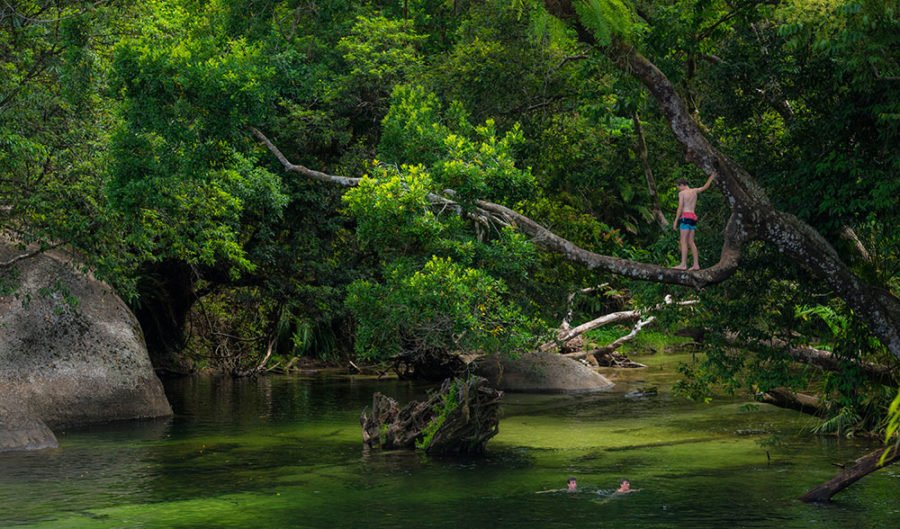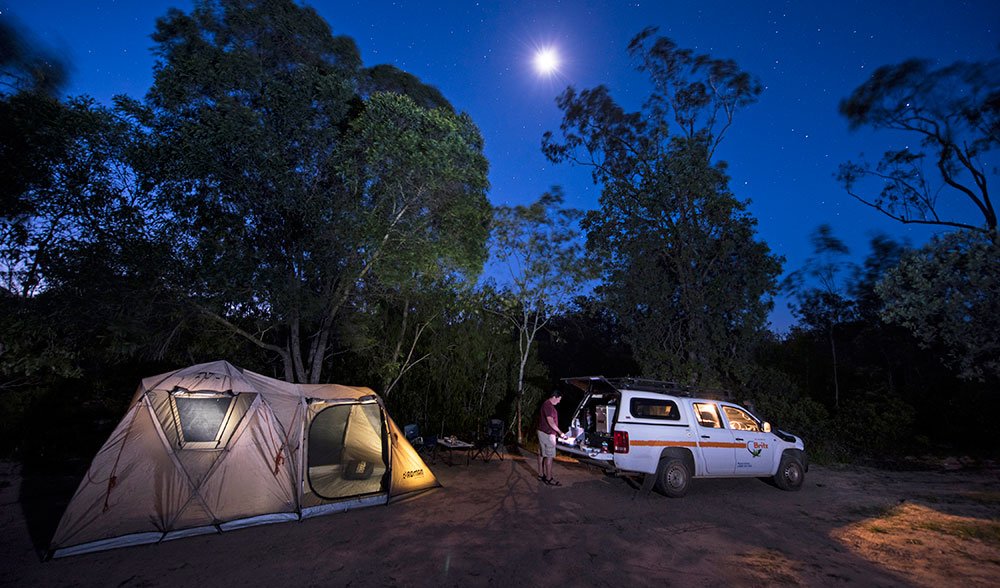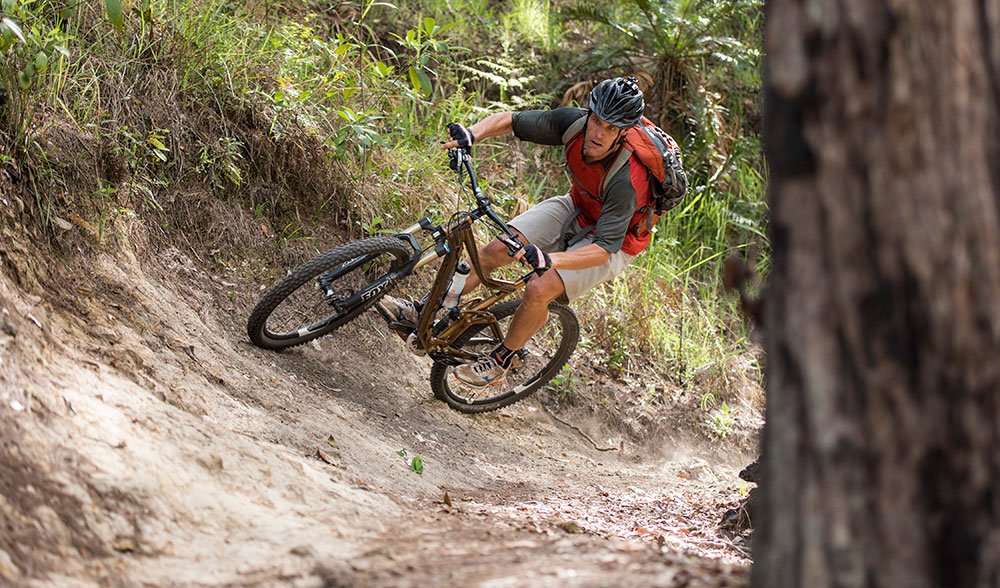Rainforest to reef: Tropical North Queensland

I WAS GOBSMACKED. A massive Queensland groper lazily swam over to my sea kayak before performing the aquatic equivalent of buzzing the tower, swimming directly beneath my watercraft. It was an incredibly exciting moment… well, for me, anyway. The huge fish – I reckon it was at least 2m long – looked anything but excited as it lazily swung its wide head up to give me a casual glance before it rolled back over and, with a powerful flick of its tail, disappeared into deeper water.
If there’s a better way to start a road trip, I haven’t yet experienced it; Tropical North Queensland had really turned it on. The close encounter topped off what had already been a fantastic paddle. Photographer Mark Watson and I had dragged ourselves out of bed for a pre-dawn start with Coral Sea Kayaks’ David Tofler and Atalanta “Atty” Willy, putting in at South Mission Beach and heading south along the TNQ coastline.
That early start paid huge dividends: along with the grouper, we’d also been fortunate enough to spot manta rays, green sea turtles, the ubiquitous hermit crabs and some Spanish mackerel splashing about close to shore. It had been an immensely satisfying experience – and it would have been great to explore further along the coast and out to the nearby islands – but the mountains were calling…
Over the hill

Canoing along the Tropical North Queensland coastline. (Image: Mark Watson)
Tropical North Queensland’s catchcry is “Where rainforest meets the reef”. It would be easy to write that off as just a clever marketing strategy were it not for the fact that it is so accurate in its description of this region. The narrow coastal area, dotted with sugar cane fields and banana plantations, is sandwiched between the steep, rainforest-clad mountains of the Great Dividing Range to its west, and the waters of the Coral Sea – and the Great Barrier Reef – to the east. The reef is, of course, a massive drawcard for visitors, but to just dismiss the hinterland region, encompassing the savannah plains, mighty rivers, high waterfalls and rolling green hills of the Atherton Tablelands, would be a big mistake, and one we weren’t going to make. There are any number of routes from Cairns that will take you up high to the tablelands but we were keen to take the back way, and had opted to follow the historic Kirrama Range Road that climbs up and over the rugged Cardwell Range to our overnight camp at Blencoe Falls.
Kirrama Range Road was built during the Great Depression to assist the timber industry in reaching timber reserves up in the hinterland, and also to provide much-needed employment and access to the hinterland area and beyond. Construction began in 1936 and at the time was viewed as one of the state’s most impressive works of engineering. Dug into the side of the mountain, the road was constructed nearly entirely by hand, with wheelbarrows, horse-drawn drays, jack-hammers, picks and shovels being used by the workers to hack a route through the rugged landscape to the precious timber reserves.
There are three monuments along Kirrama Range Road, with the most impressive history being attached to the one at Tuckers Lookout, named in honour of surveyor George Tucker.
Tucker was a member of the original survey party who had to slog through near-impenetrable, steep mountain country, fording numerous waterways and coping with the region’s high rainfall, all while trying to figure out how to build a road that could withstand these fierce conditions. The end result is both an engineering marvel and testament to all those who were involved in the project.
Further proof of the road-workers’ prowess is the fact the Kirrama Range Road is still here today, and it offers visitors a memorable drive over the Cardwell Range, passing through terrain ranging from thick, dense tropical rainforest to rocky, dry savannah grasslands. You don’t need a 4WD to drive this route (the only caveat being it would get very slippery in wet weather) but you do need to be cautious, as the road is quite narrow and the corners are blind; take your time and you’ll get through unscathed.
Our drive up the mountain was uneventful and quite relaxing – the road is enveloped by the rainforest – and we only passed a few vehicles coming the other way. Short stops at both Tuckers Lookout and then Murray Valley Lookout, with its views across Kirrama and Girringun national parks, broke up the journey and provided the chance to appreciate the scale of the region and its variety. This was never more evident than when we reached the road’s highest point and drove across what was an abrupt change in terrain and vegetation. It was like a border crossing, with an invisible demarcation line separating lush rainforest on one side and, not more than a vehicle’s length further on, the open savannah grasslands on the other. The change really is that dramatic, with the only constant the road itself.
A night in paradise

Blencoe Falls sits in the northwest section of Girringun National Park. Like the park itself, the waterfall is huge, with a drop of around 90m to the first large pool, before it snakes down a near-vertical gorge a further 230m. And yep, it is impressive – as is the national park campground, nestled beside Blencoe Creek, with plenty of creekside camping spots, and clean toilets. After the obligatory tent setup and a celebratory beer, we tackled the short 10-minute drive across the creek and around to the falls lookout on the western side of the gorge. Looking at the waterfall from this vantage point did nothing to lessen the impression of size: the water seemed to be flowing slowly off the edge of the escarpment but the dull roar carried to us by the wind disabused that assumption; there must have been a massive volume of water crashing down to the bottom of the gorge. I can only imagine what it must be like after heavy rain.
I have camped in some amazing locations over the years and rate Blencoe Falls campground as one of the finest. Not just for its location, or the star-filled night we were treated to, or the fact that my travelling companion proved he’s not only a handy photographer, he’s also an impressive camp chef, but because of the perfect morning we were treated to. Being woken by the sun peaking over the tree-lined ridge to our east with its accompanying birdsong, and following that with a swim in the soft fresh water of the creek, with only a few small fish for company, is tough to beat. The only negative: we were there for just one day, and I would have dearly liked to explore the many walking trails that surround the falls.
Moving on
After Blencoe Falls, Kirrama Range Road continues northwest through more savannah grasslands. As we drove, we saw increased evidence of human settlement – there are some huge cattle stations here, running the hardy Brahman cattle that are favoured in the tropical regions due to their heat tolerance and resistance to insects. These stations are all off Kirrama Range Road though, so you don’t see much in the way of buildings or other people, which explains why, when we finally did leave the wild country behind and suddenly rejoined civilisation in the form of the bitumen Kennedy Highway, and then on to Mt Garnett, it was with a little sadness.
This sadness dissipated somewhat once we reached the Palmerston Highway and stopped beside a virtual “hole-in-the-forest” entrance to a walking track that took us to two waterfalls – Wallimar and Tchupala. These two falls couldn’t have been more different; Wallimar’s curtain-like flow was blown away by Tchupala’s thunderous triple-tiered drop. We explored the top two falls that make up Tchupala, scrambling down a cliff to the second, then peeking over the lip to the picturesque pool at the bottom. The valley below here was a tangle of rainforest and raging waterway – a spectacular sight.
We were running late, and by the time we pulled into Rose Gums Wilderness Retreat, back up on the edge of the Atherton Tablelands, we’d missed the chance to explore this magical location. The retreat is not only a great place to stay a night or two, but it also offers more than 9km of walking tracks through its 93ha. The retreat’s owners – Jon and Peta Nott – worked hard to rejuvenate the landscape, and sitting on the verandah of one of the retreat’s rainforest-surrounded tree-houses, you’d be hard pressed to pick it was once part of a dairy farm. The couple’s hard work (more than 25,000 trees have been planted here since 1995) has resulted in the return of many native bird and animal species, including the southern cassowary. After a day of driving and hiking, this was the perfect end-stop.
Mountain bike heaven

Steve from Bike n Hike Adventure Tours lets rip on some of the MTB trails at Atherton Forest Mountain Bike Park. (Photo credit: Mark Watson)
I had heard, read and watched plenty about the mountain biking developments up in TNQ for a number of years, but it was still a jaw-dropping moment to actually ride some of the trails on the Atherton Forest Mountain Bike Park. This amazing trail network caters for all rider skills with a mix of green and blue grade trails making up the network. They wind over undulating terrain along the lower slopes and flats of the Herberton Range, right next to the town of Atherton itself. In fact, you can ride from town easily – it takes about five minutes to reach the link trail. Riders are treated to a mix of open forest, grasslands and fern tree-dotted gullies, with gums, grass trees and blackbutt.
We’d had an early 5am start to meet Steve from Bike n Hike Adventure Tours, along with Mark Knowles and Drew Burgess from the Tableland Cycle Sports Club. Steve is a long-time Crocodile Trophy competitor, while Mark and Drew ride these steep trails (and the surrounding roads on their road bikes) regularly and were perfect riding companions for the day. Mark told us how it was mostly community involvement that got the trail network up and going, with a government grant helping to fund the building. It sounded like a drawn-out process that would have required plenty of planning and patience on behalf of those involved but the end result is simply brilliant, and something the community can be proud of.
There are 17 trails through the network, covering more than 55km, and we had an epic day of riding, with the highlight being the descent of ‘Ricochet’, a blue-grade trail that offers immense berms, g-outs and more as you make your way down to join the lower trails before finishing at the carpark. It was a cracking few hours riding, in great company, and it is easy to see how this trail network and the others in the TNQ region have made this a world-rated MTB tourism destination. Watto and I were already plotting our return as we piled back into our vehicle for the short drive to our next destination – and more great company.
Volcanic world
Mt Quincan Crater Retreat sits on the sides of a now-dormant volcanic crater, overlooking the massive Lake Tinaroo and across the Tablelands. The view is spectacular, and the welcome from Kerry and Barb Kehoe even more so. The couple has been here since 1989 and they built the retreat – cabins are dotted on both sides of the crater and there’s a function centre as well – in 1998. They welcomed us with a hot coffee and food, and we were stoked to have Kerry as our personal guide for the rest of the day.
Once we’d settled into our cabins, Kerry dropped by and picked us up in his ute for a tour that would take in the crater and its surrounds, all while we searched for one of its most famous residents: the tree kangaroo. As Kerry said at the start of our drive, “As soon as they [tree kangaroos] see a camera, they disappear.” And he looked like being proved right as we headed into the crater, driving around its edge (the crater centre is 11.2 metres deep and full of water, covered in reeds and decaying vegetation) and then up to the top, all the while craning our heads in an attempt to spot the elusive marsupial.
Ironically, it was only when we returned to Mark’s cabin that we saw one through the trees, resting on a high branch about 30m away. The tree kangaroos are an incredible animal, with their huge long tail and small bodies belying their agility, both up high and when on the ground. To see one in the wild was a privilege.
I slept in the next morning, woken by a gorgeous red-pink sunrise suffusing my cabin in light. Watto, however, was up pre-dawn and had driven with Kerry back up to the top of the crater for some sunrise shots. Having Kerry on hand with freshly brewed coffee and breakfast meant he wasn’t exactly toughing it though.
The perfect photographic morning was confirmed when the pair spotted another tree kangaroo – much closer this time. It was more than happy to stay and pose while the camera clattered away below it.
From wetlands to the air
Every adventure road trip has to have an ending. For us, it was a memorable day and night at the incredible Mareeba Tropical Savanna and Wetland Reserve, staying at the Jabiru Safari Lodge, followed by a 3am start for an awesome balloon ride over the tablelands.
The manmade Mareeba wetlands cover around 2000ha of open savannah forest and freshwater wetland, and are the result of Tim Nevard’s passion. Tim is a past president of the Wildlife Conservancy of Tropical Queensland who has lived in this area for many years and, along with Margi and Greg who run the Lodge itself, welcomed us on our arrival. Tim is hugely passionate about the work the Conservancy does, and his enthusiasm is obvious as he takes the time to talk us through the gestation of the wetlands idea, from concept to the incredible reality just beside us as we sit in the Information Centre. The engineering that went into building it (each lagoon is separate and set up to reach a certain level before draining away from the area) is incredible, as is the birdlife that frequents it.
During our wet season visit, we spot brolga, jabiru, a whistling kite, blue-winged kookaburras, magpie geese and black swans. After chatting to Tim, we had just enough time for a drive-around with Greg before tucking into some awesome nosh from Margi, and then crashing in our safari tents in preparation for the very early start to our final day.
The Raging Thunder Adventures (RTA) team know how to put on a show. That was my first thought after we’d reached the take-off location of our balloon tour, and I had watched Steve Hawke and other RTA crew prep and then make airborne half-a-dozen balloons.
Actually flying one of these things is a black art. As Steve explains, he’s been flying balloons for 23 years and is still amazed at how a balloon uses layers of wind currents to manoeuvre to its landing spot. When he started flying, navigation was by compass; now balloon pilots use GPS (for direction) and a variometer/altimeter. Pretty amazing stuff when you consider that, even in this hi-tech age, we are still very much at the mercy of nature, in this case in the form of wind currents. Nevertheless, Steve did a great job and we’re soon down from the lofty heights, where we’d been able to view the true expanse of the tablelands before being dropped off back at our vehicle. Incredibly, it was only an hour’s drive “down the hill” before we were back in the hustle and bustle of Cairns.
We’d barely been a week away, but with the wilderness and adventure we’d experienced – from the night camping beside Blencoe Creek to the mountain biking in Atherton and then floating above it all in the balloon – it felt like we’d been away for a lifetime, which is not a bad feeling to have…
The essentials
Getting there: Qantas flies direct from Sydney to Cairns daily. For other capital city flights to Cairns. See www.qantas.com.au.
Vehicle hire: Britz hires out fantastic 4WD-based camp vehicles, ideal for this region.
The adventure: Cairns could easily be dubbed the adventure capital of Australia. With numerous outdoor activities close by, you can pack in plenty of excitement over the course of a week. Check these links below.
Queensland National Parks: http://www.nprsr.qld.gov.au. To camp in Girringun National Park at Blencoe Falls, you need to book. The excellent national parks website also has comprehensive guides to activities in all the TNQ parks.
Coral Sea Kayaking: www.coralseakayaking.com.
Atherton Forest Mountain Bike Park: http://tablelandcyclesports.com.
MTB in TNQ region: www.ridecairns.com.
Guided MTB: www.bikenhiketours.com.au. Steve at Bike n Hike Adventure Tours offers some brilliant riding trips around the TNQ region.
Raging Thunder Adventures: www.ragingthunder.com.au.
Accommodation TNQ offers a range of accommodation, from national park campgrounds through to beautiful resorts right on the beach.
Castaways Resort and Spa: www.castaways.com.au.
Mt Quincan Crater Retreat: www.mtquincan.com.au.
Rose Gums Wilderness Retreat: www.rosegums.com.au.
Jabiru Safari Lodge: www.jabirusafarilodge.com.au.
SEE MORE:
- GALLERY: Four days in Tropical North Queensland
- Tropical oasis of Magnetic island
- Trekking tropical Hinsbrook Island’s Thorsborne trail
- Weekend escapes: Cairns, Queensland
- GALLERY: Heron Island, Queenslands tropical paradise

